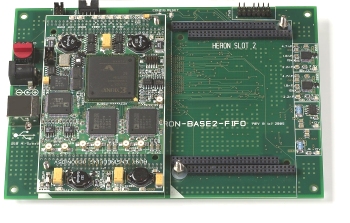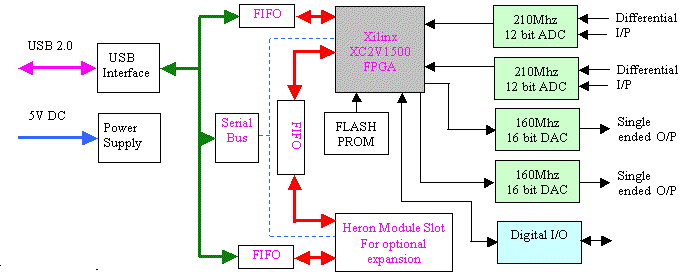 |
RTG001
- USB
主板連接1.5百萬FPGA
system,資料擷取與信號處理(包含高速的A/D和D/A) |
|

- User programmable Xilinx
XC2V1500-6 FPGA.
- 2 channels of 210Mhz 12
bit A/D
- 2 single ended
(optionally differential) channels of 160Mhz 16 bit D/A
- 8 bits digital I/O
- Hi Speed (480Mbits/sec)
USB 2.0 connection to a host PC.
- Can be used as a stand
alone board for embedded systems.
- FPGA can be configured
via USB, Xilinx JTAG cable or from on-board PROM
- Single 5V power supply
required ?20W mains Power Supply Unit included
Host API supported for Windows 2000 and XP and Linux
FPGA and DSP loading, resetting and data exchange all
performed with simple to use software interface.
- Optional expansion via
HERON module slot
|
| |
 |
| |
The fast A/D and D/A channels
are directly connected to the user programmable FPGA,
allowing data to be processed by a user FPGA program. The
FPGA can be used to perform digital processing between the
analogue inputs and outputs, or the data can be passed to
and from a PC using the USB 2.0 connection and provided
software.
The USB connection is supported via the Host-API software.
This allows software applications and tools on the Host PC
to access the hardware using a consistent software interface
without the need to understand or program the hardware or
USB directly.
The FPGA program can be loaded over the USB connection using
a software tool that directly accepts the output from
development tools for the Xilinx FPGA. Alternatively a
Xilinx JTAG cable (Parallel or USB) can be used to load the
FPGA and or program the on board configuration PROM.
The FIFO connections can be used to stream data to or from a
module in the system. They are capable of up to
50Mbytes/second in each direction, but the Host PC, its USB
controller and the operating system will all impose their
own limits to this speed.
The system is delivered ready to go with a power supply
(requires an IEC lead specific to your country), USB cable,
I/O cables and a CD with all of your documentation, software
tools and examples. The only other thing you need are
development tools for the Xilinx FPGA, for example Xilinx
Foundation ISE from
www.xilinx.com .
- Analogue I/P
2 differential input
channels with common or independent clocking set by
jumper
Standard Input characteristics:
+/-0.768mV differential inputs each on 2 MMT
co-axial connectors (U.FL if you choose the
differential output option)
A/C coupled 50R, signal B/W from 200Hz to 450Mhz
Zero input noise typically 3 levels maximum 8 levels
Offset typically +-3 levels maximum +-8 levels
Optional Input types:
D/C
D/C coupled 50R - Signal B/W 0hz to 450Mhz but each
input must not exceed the range 0v to +3.3V (of this
module). This means a 2.8V DC offset is required.
Zero input noise typically 3 levels maximum 10
levels
Offset typically +-8 levels maximum +-16 levels
- Analogue O/P
specifications
Standard Output
characteristics:
2 single ended channels with independent clocking
+/-0.374V single ended output on MMT co-axial
connector
A/C coupled 50R, signal B/W from 725Hz to 200Mhz
Optional Output types:
D/C 50R, signal B/W 0 ?200Mhz
Differential
+/-2.1V differential, on a pair of U.FL co-axial
connectors per channel
A/C coupled 50R, signal B/W from 750Hz to 145Mhz
D/C coupled 50R, signal B/W from DC to 145Mhz
|

|
|

